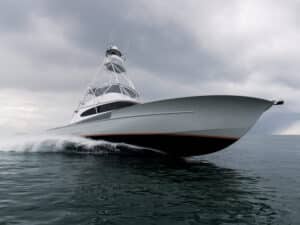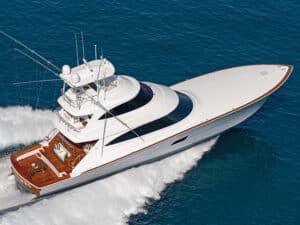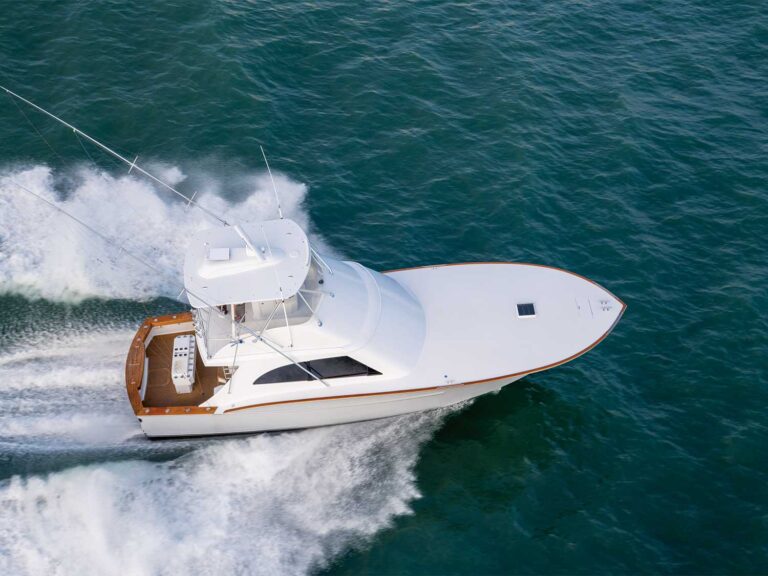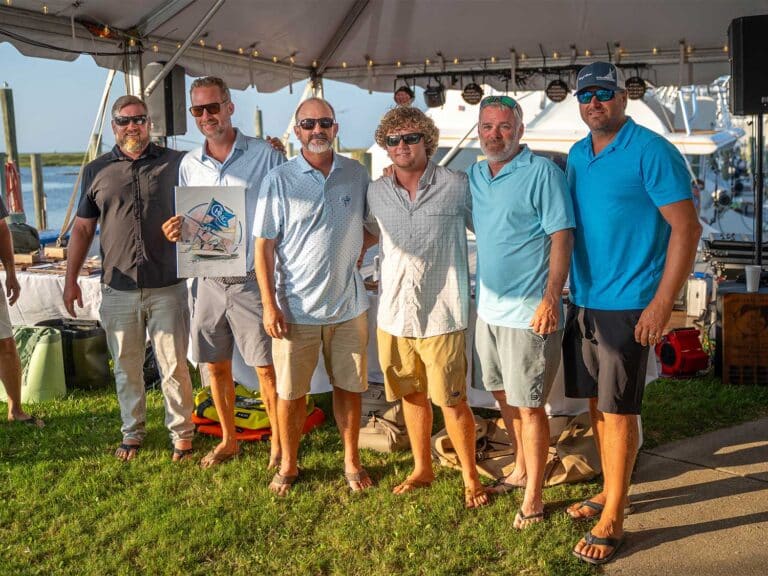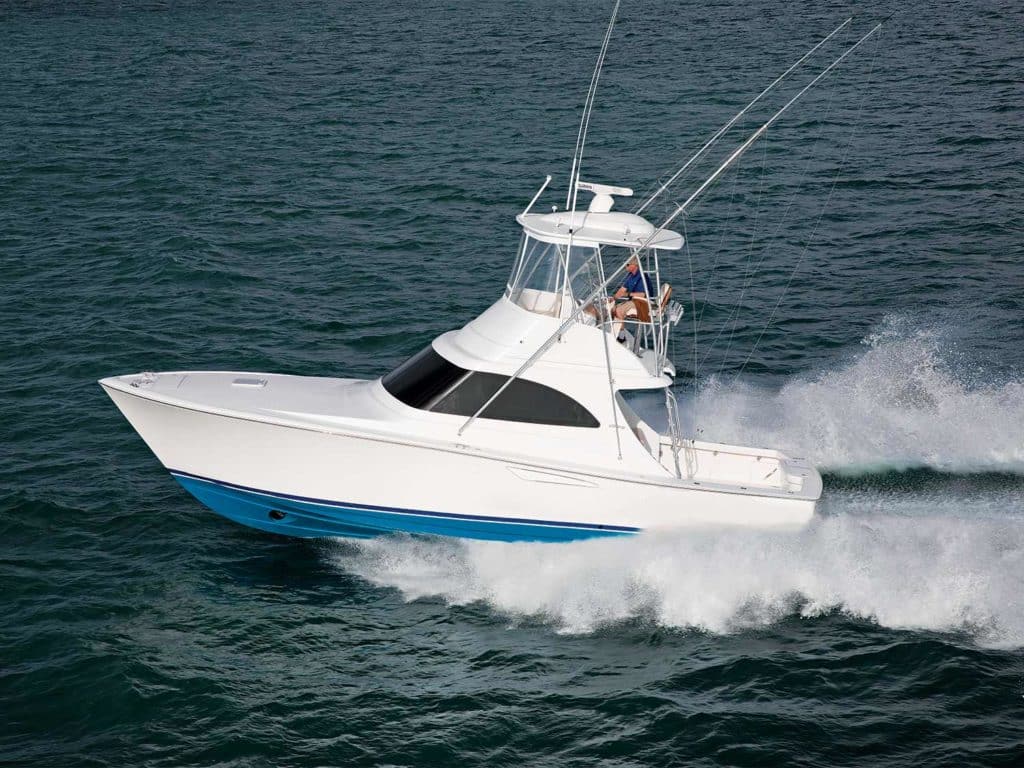
Ocean Yachts introduced the Billfish concept in 2007 as a reprise of the classic dayboats of yesteryear, but the economic downturn of 2008 drove the final nail into the coffin of this once-prolific builder. A decade later, the 37 Billfish was reborn when Viking Yachts purchased the Ocean manufacturing facility in nearby Egg Harbor City, New Jersey, and added the model to its extensive line of sport-fishing boats. The boat became an instant success and spawned the 38 Billfish—which made her debut earlier this year—and the 46 Billfish that was introduced at the annual Viking dealer meeting in Atlantic City, New Jersey, in September.
“Everyone at Viking fell in love with the 37, and the customers did too,” says project manager John Leek IV, general manager of Viking Mullica, where the Billfish series is built. “The original concept of a purpose-built fish boat that was perfect for the owner/operator to handle and maintain economically was well-received, but after building so many, it was time to retire the molds and retool. That gave us the opportunity for a total update and to make what was already a great boat even better.”
The 38’s proportions are nearly identical to the 37, with the same waterline length but a slightly wider beam. To me, the boat felt larger than her predecessor, especially in the cockpit. The increase in length overall was accomplished by raking the stem farther forward, giving the boat a racier look similar to the current Viking convertibles on the market.

Construction
Viking’s in-house design and engineering staff started with a total redesign of the hull and stringer system, which included a new running surface. Joe Snodgrass, lead naval architect on the project, used computational fluid dynamics (CFD) software that allowed him to make modifications to the bottom and run a virtual tank test on each tweak to see how the performance characteristics were affected. CFD has replaced time-consuming model tank testing, and has proven to be even more accurate in predicting real-world hull performance.
Every major component has been refined to precision tolerances using molds created with Viking’s five-axis CNC machine process. End-grain balsa and closed-cell foam are used as coring materials in selected areas for optimized strength and stiffness while minimizing weight. The hull is stiffened with a molded eggcrate-type stringer system, and the entire build has been fine-tuned to provide the highest level of quality possible.
| LOA: | 38’8″ |
| Beam: | 14′ |
| Draft: | 3’4″ |
| Displ.: | 30,953 lb. |
| Fuel: | 460 gal. |
| Water: | 69 gal. |
| Power: | Twin 550 hp Cummins QSB 6.7 |
| Gears: | ZF |
| Propellers: | Acme, 4-blade |
| Paint: | Antifouling—Interlux Micron CSC |
| Climate Control: | Dometic |

Engine Room
An oversized centerline day hatch provides quick access to the engine room, and both seating areas of the command deck rise on electrically actuated rams to expose the entire engine compartment for maintenance. The new fiberglass 460-gallon fuel cell allowed Viking to add 20 inches of length to the engine room for a more organized layout and improved access.
The engine room is filled with big-boat details such as a five-port oil exchange system for the engines, transmissions and Onan 9-kW generator, while a Delta T cross-ventilation system feeds air to the engines and keeps the space cool. The Dometic air conditioning is a direct expansion, single-zone system with reverse cycle heat, and an optional Seakeeper 6 gyrostabilizer is positioned on the centerline between the transmissions with a removable deck hatch above it for servicing.
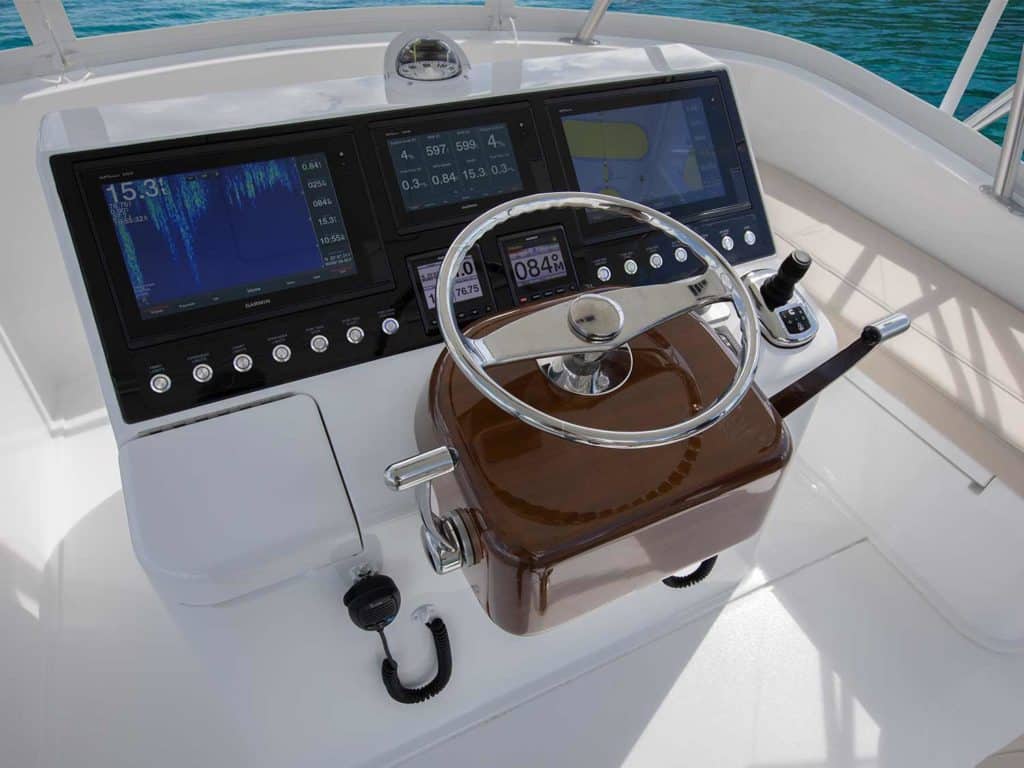
Command Deck, Cockpit and Bridge
To port, a U-shaped seating area and table mimics an interior salon layout, with additional seating to starboard. Rod storage under the starboard bench seat and an upright drink refrigerator are nice touches, and the beautifully executed curved windshield flows gracefully into the side windows.
The cockpit measures 109 square feet with a substantial transom livewell, and the large insulated fish boxes lift out, providing access to the exhaust system and running gear. There are twin mezzanine seats and the lazarette is deep and spacious. More big-boat features include a cockpit bait freezer, dockside water connections and under-coaming and flybridge overhang tri-color LED lighting.
The flybridge offers guest seating for up to six in a center console design, complete with Palm Beach-style engine controls. Viking subsidiary Atlantic Marine Electronics designed and installed the electronics, navigation and communication package, including twin Garmin GPSMAP 8612 multifunction displays, as well as the other touchscreen displays and system monitors. The 360-degree view is unobstructed, thanks to the Costa Clear enclosure.

Belowdecks
A watertight aluminum door located on the forward bulkhead of the command deck leads to the boat’s interior, which is swathed in beautiful high-gloss teak cabinetry. The starboard-side galley is surprisingly large and includes plenty of Corian countertop space and a stainless steel sink. A large pantry, two-drawer Isotherm freezer/refrigerator with ice maker, microwave and two-burner electric range help with meal prep. The main electrical panel is on the aft bulkhead and protected behind a teak door that opens via gas pistons. A beautifully appointed head with stand-up shower is found to port and the master stateroom includes a double bed, two hanging lockers and ample drawer and storage cabinet space. Another storage compartment on the port side outboard of the bed is perfect for keeping tackle safe and out of sight.
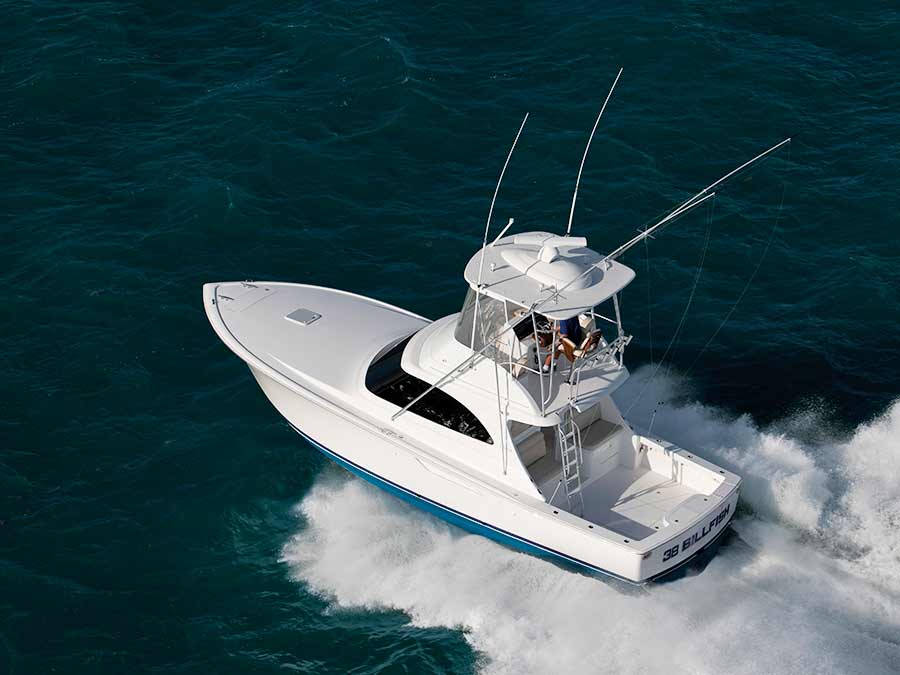
Performance
The twin Cummins QSB 6.7 550 hp diesels are a perfect match for this 38-foot hull. We ran the boat from Farley State Marina in Atlantic City, New Jersey, using the joystick to pick our way through the slips and bulkheads before switching to the single-lever controls for the run to the inlet. A 20-plus-knot wind from the east had blown through the night, generating solid 2- to 4-footers. The Billfish handled it beautifully at slower speeds, but even better when the throttles were pushed up to 30 knots. The new bottom really shines in tight turns, and when the boat was turned hard over in a near-full throttle 360-degree turn, it accomplished the task in about three boat lengths without cavitation. The boat also does an admirable job in reverse, making short work of quick direction changes.
Overall, the boat was a pleasure to run, providing excellent fuel economy. Wide-open throttle of 3,300 rpm produced speeds of 35 knots with a fuel burn of 55 gallons per hour. A brisk 30-knot cruise at 2,900 rpm drops the fuel consumption to just 39 gph, and throttled back to 2,600 rpm, the 38 Billfish still made 26 knots while burning a tad more than 30 gph—the perfect speed for a run to the canyons or the Bahamas. At that speed, operators will enjoy a range of 366 nautical miles.
Check out our exclusive first look at the Viking 46 Billfish.
The previous Billfish model was a major success for Viking Yachts, earning it a slew of new followers, and I anticipate a similar response with this one. There is little question this legend will continue for yet another generation of adventurous offshore anglers.


